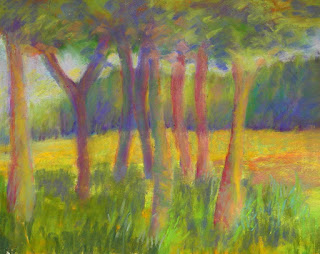Lots of writers struggle with the opening to their books, no
matter what genre. I'm working with one client in my retainer coaching
program who is writing a very large story--it spans thirty years or
more. It's a memoir, and a lot has happened to her in her long life, so
choosing the starting moment is very challenging for her.
We begin by asking what this book is about. "My life," she answers, and that's true. But I ask again, "What's it really about?"
I'm asking her: What's the focus? What's the subject of your story, the part you're going to include in this particular book? Not your entire life. What will you select and why?
Everything you select for your book, whatever genre, sits within a frame. Imagine a photo frame that holds the photograph of your story. Just like any photo, it shows selected segment, a slice of a life. When you find yourself at a loss to imagine this frame--as my client said, "I can't not put that in, or that either--that has to go in"--you don't yet have a frame.
It can take a while to figure out the frame of a story. Dani Shapiro, in her excellent writing-craft book, Still Writing, discusses the idea that we write against the edge of a frame that defines our work. She likens it to a window we're looking out of, a particular view. This window, not that one--this part of the story, not that.
One of the hardest decisions a writer will make is that of frame. Because it means not including everything.
Opening and closing your book is dependent on the frame. Many writers choose a scene that takes a snapshot of the whole book--a little hologram--for their opening. Like standing back and photographing the view out the window or the image in the frame. We set up, in that first chapter, whatever the main topic will be.
A great example is The Glass Castle, by Jeannette Walls. The opening scene shows the narrator in a taxi in New York City, seeing a homeless woman rooting through a dumpster and realizing it's her mother. The frame of her story is mentally ill parents. We see the disparity between her (in the taxi) and her mother (as a street person), as well as the ending foreshadowed--she won't be able to change or take care of her parents, but she can divorce herself from them, even though it hurts terribly.
Your weekly writing exercise is to consider the frame of your story. What are its boundaries? What will be included and what not? Think of time span (how much time you'll cover), events (which ones), people (who belongs in the story and why), and the main topic. Not just "my life," but "my life after my father died" or "my life with a mentally ill sister" or "my life as a woman carpenter." That's the frame, the window you'll look out of for this book.
We begin by asking what this book is about. "My life," she answers, and that's true. But I ask again, "What's it really about?"
I'm asking her: What's the focus? What's the subject of your story, the part you're going to include in this particular book? Not your entire life. What will you select and why?
Everything you select for your book, whatever genre, sits within a frame. Imagine a photo frame that holds the photograph of your story. Just like any photo, it shows selected segment, a slice of a life. When you find yourself at a loss to imagine this frame--as my client said, "I can't not put that in, or that either--that has to go in"--you don't yet have a frame.
It can take a while to figure out the frame of a story. Dani Shapiro, in her excellent writing-craft book, Still Writing, discusses the idea that we write against the edge of a frame that defines our work. She likens it to a window we're looking out of, a particular view. This window, not that one--this part of the story, not that.
One of the hardest decisions a writer will make is that of frame. Because it means not including everything.
Opening and closing your book is dependent on the frame. Many writers choose a scene that takes a snapshot of the whole book--a little hologram--for their opening. Like standing back and photographing the view out the window or the image in the frame. We set up, in that first chapter, whatever the main topic will be.
A great example is The Glass Castle, by Jeannette Walls. The opening scene shows the narrator in a taxi in New York City, seeing a homeless woman rooting through a dumpster and realizing it's her mother. The frame of her story is mentally ill parents. We see the disparity between her (in the taxi) and her mother (as a street person), as well as the ending foreshadowed--she won't be able to change or take care of her parents, but she can divorce herself from them, even though it hurts terribly.
Your weekly writing exercise is to consider the frame of your story. What are its boundaries? What will be included and what not? Think of time span (how much time you'll cover), events (which ones), people (who belongs in the story and why), and the main topic. Not just "my life," but "my life after my father died" or "my life with a mentally ill sister" or "my life as a woman carpenter." That's the frame, the window you'll look out of for this book.













No comments:
Post a Comment